Mali: Bamako to Sevare
 On Tuesday morning we drove out of a smoke-filled Bamako as everyone began preparing to cook their sheep for the Tabaski holiday the following day. Once we left the city the air cleared and we drove through an area of very cool rock formations, then into a zone of lush forest, then finally into a Sahelian scrub landscape that became drier the further north we went. After several hours we crossed the Bani River, one of the largest tributaries of the Niger River. The Bani is created from two other rivers, the Baoule and the Bagoe, which flow from the mountains of Ivory Coast to the south. It still feels odd to me that rivers flow to the north here.
On Tuesday morning we drove out of a smoke-filled Bamako as everyone began preparing to cook their sheep for the Tabaski holiday the following day. Once we left the city the air cleared and we drove through an area of very cool rock formations, then into a zone of lush forest, then finally into a Sahelian scrub landscape that became drier the further north we went. After several hours we crossed the Bani River, one of the largest tributaries of the Niger River. The Bani is created from two other rivers, the Baoule and the Bagoe, which flow from the mountains of Ivory Coast to the south. It still feels odd to me that rivers flow to the north here.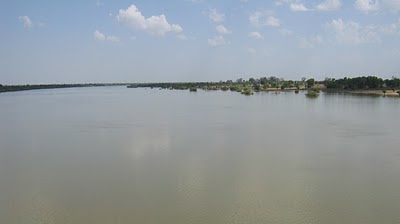 After lunch in Segou we stopped at the town of San, where we had arranged to meet Mr. Berthie who works for the Niger River Basin Authority in that area. We met him at his house and were also joined by another man who is the son of the local “water chief”. After drinking the customary cup of tea, we set off in a four wheel drive through miles of flooded rice fields, driving on the top of narrow dikes and dodging donkey carts piled high with hay.
After lunch in Segou we stopped at the town of San, where we had arranged to meet Mr. Berthie who works for the Niger River Basin Authority in that area. We met him at his house and were also joined by another man who is the son of the local “water chief”. After drinking the customary cup of tea, we set off in a four wheel drive through miles of flooded rice fields, driving on the top of narrow dikes and dodging donkey carts piled high with hay.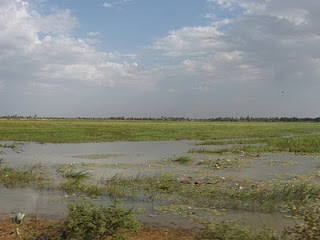 After about 10km we reached a village called Sokon at the edge of the Bani River. The village is in a fairly remote area and it was important to us because the people here report that they regularly see manatees. When we arrived we first met with the chief to say hello and explain our interest in manatees. He was an older man who assigned a younger man from the village to give us a tour near the river’s edge. As we walked to the river we passed this traditional mosque which I thought was neat.
After about 10km we reached a village called Sokon at the edge of the Bani River. The village is in a fairly remote area and it was important to us because the people here report that they regularly see manatees. When we arrived we first met with the chief to say hello and explain our interest in manatees. He was an older man who assigned a younger man from the village to give us a tour near the river’s edge. As we walked to the river we passed this traditional mosque which I thought was neat. 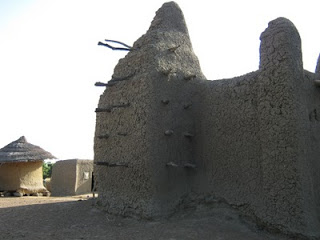 The rainy season ended about a month ago so the waters that flooded a huge plain are now receding back to the river. We learned that just as the Senegal River floods a huge area and the manatees swim onto the floodplain to feed on the grasses and trees, the same thing happens here. People see large groups, mating herds and babies. They estimated the largest group was about 20 manatees. During the dry season the locals told us they know of three deep holes in the river where the manatees stay. They can only be reached by boat and we didn’t have time to go that day, but hopefully Mr. Berthie will follow up with this. There are no manatee hunters in the village but they did have some manatee bones which they consider sacred; the cheif told us manatee bones have magic.
The rainy season ended about a month ago so the waters that flooded a huge plain are now receding back to the river. We learned that just as the Senegal River floods a huge area and the manatees swim onto the floodplain to feed on the grasses and trees, the same thing happens here. People see large groups, mating herds and babies. They estimated the largest group was about 20 manatees. During the dry season the locals told us they know of three deep holes in the river where the manatees stay. They can only be reached by boat and we didn’t have time to go that day, but hopefully Mr. Berthie will follow up with this. There are no manatee hunters in the village but they did have some manatee bones which they consider sacred; the cheif told us manatee bones have magic.
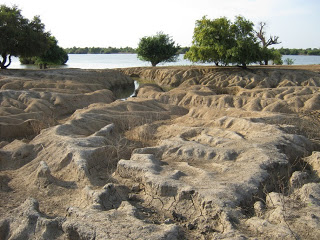 At the height of the rainy season, the water level reaches the leaves of the trees, at least a 2 meter rise.
At the height of the rainy season, the water level reaches the leaves of the trees, at least a 2 meter rise.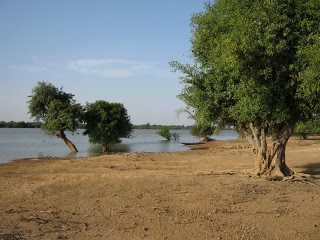 We also found some freshwater mollusk shells but no one knew if the manatees eat them as they do in other places. Another mystery to solve!
We also found some freshwater mollusk shells but no one knew if the manatees eat them as they do in other places. Another mystery to solve! 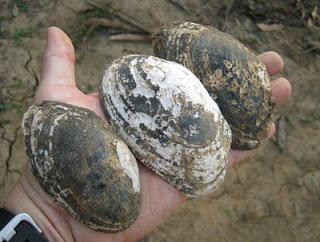
 Before we left Sokon we returned to the chief’s house to thank him and tell him we hope to learn more about manatees here in the future. Then he gave me a chicken as a gift! Never had that happen before! Not to accept it would’ve been rude, but I can’t exactly travel with a chicken, so I gave it to Mr. Berthie for his family.
Before we left Sokon we returned to the chief’s house to thank him and tell him we hope to learn more about manatees here in the future. Then he gave me a chicken as a gift! Never had that happen before! Not to accept it would’ve been rude, but I can’t exactly travel with a chicken, so I gave it to Mr. Berthie for his family.

Later that night, after 14 hours on the road, we reached Sevare.

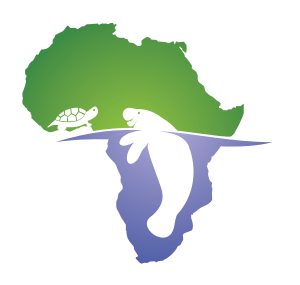
Impressive travelogue, nice. I have learned some more about the banks of the river Niger..